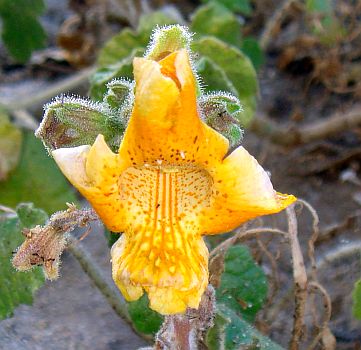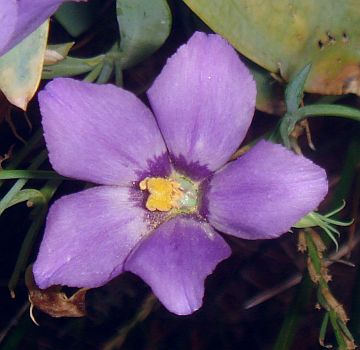Bloom Reports from the Anza-Borrego Desert: 2012-2013
 |  |
| Pictures taken on 10 October 2012. A single plant of desert unicorn-plant, aka yellow-flowered Devil's Claw, Proboscidea althaeifolia, was still in bloom in the Smuggler Canyon area; the rest were entirely in fruit, showing their unripe unicorn fruit and their ripe devil's claws. Six plants of catchfly prairie-gentian, Eustoma exaltatum, were on their last flowers at Agua Caliente County Park. Both flowers are fairly large, about the size of your thumb.
See also Pictures shown here on prior dates. | |
See Bloom Reports from the Anza-Borrego Desert for an introduction to this page, extensive general information (not specific to this year) about Annual Germination, Growth and Blooms, including what influences the duration and extent of the annual bloom, photo galleries, and links to other webpages giving information on Anza-Borrego Desert State Park Blooms.
Summary of Annual Germination, Growth and Blooms in 2012-2013
The 2012 summer monsoon was very active in the entire desert, and germinated monsoonal annuals nearly everywhere. However, the continuous 100° plus heat every single day in August and September 2012 has ended the bloom for most of the annuals at elevations of ~2000 feet and below. Some perennials like Allionia incarnata, trailing four o'clock, are still in good bloom at lower elevations.
Higher elevations in some areas are still looking pretty good. On our 10/10/12 trip to check out the monsoonal blooms, we found over 1,000 plants of 54 species in bloom! In particular, Sentenac Gorge (SR78 below Scissors Crossing) was ablaze with blooms from Viguiera parishii, Parish's goldeneye. The hillsides there are yellow from it now.
However, unless we get fall rain, we expect the number of plants in bloom from the monsoonal rains to decline markedly, as it usually does. See Number of Species and Plants in Bloom On Each Trip for how the monsoonal bloom usually declined into winter last year.
The monsoonal bloom is even better in parts of the Mojave Desert, especially in the Granite Mountain and New York Mountain area, due to their higher elevation and greater monsoonal rainfall. On 22-23 September 2012, we found 111 species in bloom!
See also:
- Detailed Germination, Growth and Bloom Reports From Each Hike: 2012-2013.
- Pictures From Each Hike: 2012-2013.
- Number of Species and Plants in Bloom On Each Trip: 2012-2013.
- List of Species in Bloom On Each Trip, With Photographs: 2012-2013.
Predictions for This Year
It is far too early to make any predictions for this year, other than to note that the monsoonal rainfall received nearly everywhere in the desert from late July to late September 2012 has given the perennials, shrubs and trees a good start. Winter annuals, after they germinate from a winter rain, may benefit as well from stored moisture in the soil from the summer rains.